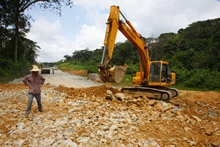
Typical street scene in Santa Ana, El Salvador. (Photo: iStock)
IMF Survey: Central African Currency Union Targets Closer Regional Ties
July 5, 2012
- Macroeconomic performance good last year in uncertain global economy
- Vulnerabilities with region's financial sector are source of concern
- Non-oil economic activity constrained by inadequate infrastructure
High oil prices have enabled the Central African Economic and Monetary Community (CEMAC) to accumulate foreign reserves and comfortably finance an ambitious investment program, maintaining growth while keeping debt in check.

Road project in Bamenda, Cameroon: CEMAC’s infrastructure bottlenecks hamper trade, limit gains from regional integration (photo: Heiner Heine/Newscom)
ECONOMIC HEALTH CHECK
But, the IMF said in its regular assessment of the currency union’s economy, the ongoing problems in the eurozone underline the need to better coordinate fiscal policies and to strengthen external competitiveness.
Financial sector stability requires stronger supervision of the union’s banking system as well as enhancing the regulatory framework, including the crisis management framework. In addition, the non-oil economy is constrained by structural obstacles, including low intraregional trade and inadequate infrastructure.
The CEMAC is an economic and currency union comprising Cameroon, the Central African Republic, Chad, the Republic of Congo, Equatorial Guinea, and Gabon. All except the Central African Republic are oil exporters, and oil accounts for nearly 90 percent of regional exports or 40 percent of GDP.
Macroeconomic performance in 2011 was good in an uncertain global economy, with the region registering GDP growth of 4.6 percent compared with 5.1 percent in 2010. But despite its oil wealth, the CEMAC still has some of sub-Saharan Africa lowest human development and business indicators. Financial access—the proportion of citizens with bank accounts and commercial loans—is among the lowest in Africa.
Advantages of integration
Higher and more inclusive economic growth is necessary to address the region’s still widespread poverty. Accordingly, regional infrastructure bottlenecks should be removed and intraregional mobility strengthened so that the region can fully benefit from the advantages of economic integration.
At about 1.2 percent of total trade, intraregional trade is the lowest among regional trade groups in sub-Saharan Africa. The lack of functional transportation corridors among CEMAC countries is the prominent infrastructure bottleneck that hampers trade and limits the gains from regional integration. As a result, the CEMAC region trails the overall sub-Saharan African oil exporters grouping in non-oil GDP growth.
A Regional Economic Program has been formulated to promote infrastructure and land development. The program could enhance growth and competitiveness and strengthen economic integration, and transform the region into an emerging market by 2025.
Weak bank supervision
Vulnerabilities within the CEMAC’s financial sector are a source of concern. Strengthening the financial sector would require improvements in the quality of banking supervision and regulatory framework.
In particular, supervision is weak and resolving the problems of troubled banks takes a long time. Overall compliance with the regional prudential ratios is low even though several prudential standards are weaker than the international norm. On-site examinations routinely find an even weaker than reported observance of prudential regulations. Work by the region’s central bank, the Bank of Central African States, on developing a crisis resolution framework is taking longer than anticipated.
Toward greater fiscal convergence
The CEMAC’s current fiscal convergence framework, which requires a debt stock of below 70 percent of GDP and a positive overall fiscal balance, does not impose a binding constraint to spending because governments have generous oil revenues. This framework needs to be enhanced so that fiscal policies are well integrated into an overall macroeconomic framework.
Notably, binding fiscal rules cast in a medium-term fiscal framework are needed to ensure fiscal sustainability while providing space for investments in physical and human capital in line with the region’s limited absorptive capacity. To this end, there is ongoing work toward establishing binding fiscal rules that also seek to accommodate cross-country structural differences.


